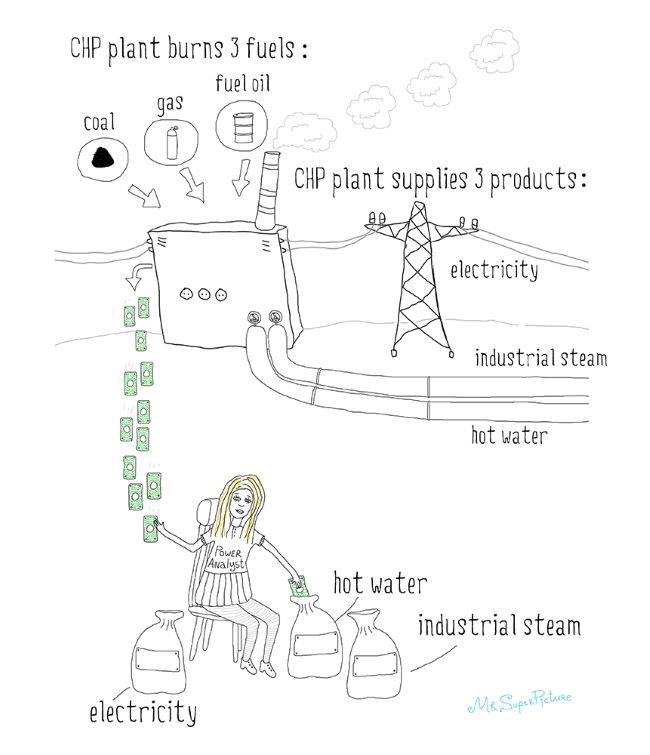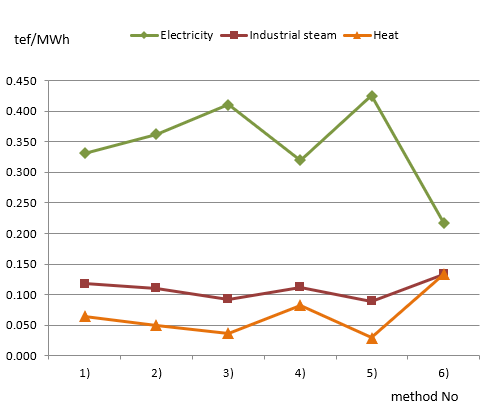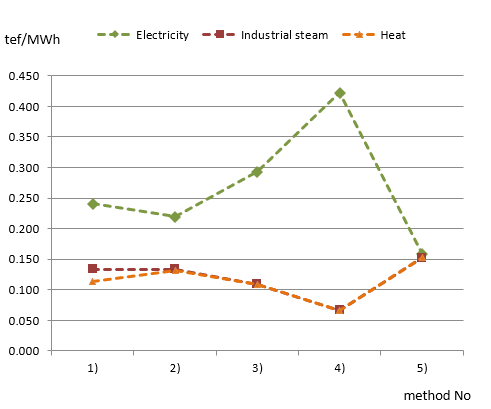PDF version of the paper (0.4 MB).

4.1.Thermodynamic methods comparison
4.1.1.Comparison principles
4.1.2.Efficiency, advantages, and disadvantages
4.1.3.Numeric analysis
4.2.Economic method comparison
4.2.1.Comparison principles
4.2.2.Efficiency, advantages, and disadvantages
4.2.3.Numerical analysis
Conclusion
Considering the fact that the thermodynamic and economic cost allocation methods have been developed to achieve different goals, the methods are compared separately by group.
4.1. Thermodynamic methods comparison
4.1.1. Comparison principles
The most important feature of the thermodynamic methods is their ability to take into consideration
- the differences between thermal (steam) energy and electric energy
- the differences between various types of thermal (steam) energy.
In the first stage for each method, I examine whether it allows considering the differences mentioned above. If both kinds of differences are exhibited, I regard such a method as effective; if only one type of difference is present, the method is regarded as less effective; finally, if no differences are considered, the method is marked ineffective.
In the second stage, I order the methods within the corresponding subgroup as their applicability decreases (effective, less effective, and ineffective).
4.1.2. Efficiency, advantages, and disadvantages
Based on the principles stated in the previous section, I compared the thermodynamic methods. The results are given in Table. 2.
| No. | Method | Differences between thermal energy and electric energy | Differences between various types of thermal energy | Mechanisms to make differences | Efficiency |
|---|---|---|---|---|---|
| 1 | Exergy method (section 2.2.2) | Considered | Considered | Exergy | Effective |
| 2 | Work method (sections 2.2.4, 2.3.2) | Considered | Considered | CHP plant equipment characteristics | |
| 3 | Method based on the linear steam turbine characteristic curve (section 3) | Considered | Considered | Steam turbine linear characteristic curve coefficients | |
| 4 | Proportional distribution method by ORGRES (section 2.2.3) | Not considered | Considered | Steams coefficient | Less effective |
| 5 | Steam consideration method (section 2.2.5) | Not considered | Considered | ||
| 6 | “Physical” method (section 2.2.1) | Not considered | Not considered | Ineffective |
1) The exergy method (sections 2.2.2) is the most commonly used and considered the most "fair" and exact thermodynamic method [2], [4]. It allows examining the differences between various types of energy using exergy. Its main disadvantages are a large number of calculations and a significant number of input data [2], [4].
2) The work method (section 2.2.4) is one of the most commonly used thermodynamic methods since it allows examining the differences between various types of energy using the technical characteristics of the CHP plant equipment [2], [4]. The main disadvantages of this method are a large number of calculations and a significant number of input data [2], [4].
3) A new method proposed in this paper takes into consideration the differences between various types of energy using the coefficients of the linear steam turbine characteristic curve. Another advantage of this method is calculation simplicity. The disadvantage of this method is the necessity to find the linear steam turbine characteristic curve equation (section 3.2).
4) The advantage of the proportional distribution method by ORGRES (section 2.2.3) is the consideration of various types of thermal energy using special coefficients. Its disadvantage is the lack of comparison between electrical energy and thermal energy. The other disadvantages of this method are a large number of calculations, a significant number of additional input data, and a confusing calculation sequence [4].
5) The steam parameters consideration method (section 2.2.5) is similar to the proportional distribution method by ORGRES in its advantages and disadvantages [4].
6) The “physical” method (section 2.2.1) is mostly criticized by researchers [3], [4], [8]. This method ignores the differences between the types of energies and does not meet the Second Law of Thermodynamics [4], [8]. According to the author [4], during USSR time, the background of the method application is the following: "The application of this method has allowed to artificially reduce the CHP plants electricity fuel rates and, without any technical development, take leading positions in the world energy industry." The use of this method as an official approach leads to artificial increases in heat tariffs [3]. The only advantage of this method is its simplicity [4].
4.1.3. Numeric analysis
In this paper, all the above-considered thermodynamic cost allocation methods have been implemented. The input data for the calculations are taken from the guidelines [4]. The results (fuel rates and product costs) are presented in the xlsx-appendix. As I mentioned in the Preface to the English version, the fuel rate values are being compared.
The obtained fuel rate values for the co-generated CHP plant products are gathered in Table 3 and illustrated in Fig. 1.
| No. | Method | Fuel Rate, tef/MWh | ||
|---|---|---|---|---|
| Electricity | Industrial Steam | Heat | ||
| 1 | Exergy method (section 2.2.2) | 0.331 | 0.117 | 0.065 |
| 2 | Work method (section 2.2.4) | 0.362 | 0.110 | 0.050 |
| 3 | A new method on linear steam turbine characteristic curve (section 3) | 0.411 | 0.093 | 0.037 |
| 4 | Proportional distribution method by ORGRES (section 2.2.3) | 0.320 | 0.112 | 0.083 |
| 5 | Steam parameter consideration method (section 2.2.5) | 0.425 | 0.090 | 0.030 |
| 6 | “Physical” method (section 2.2.1) | 0.218 | 0.134 | 0.133 |

For the methods being considered, the value bE is within the range of 0.218 to 0.425 tef/MWh; the value of , bM – 0.090 to 0.134 tef/MWh; the value of bL – 0.030 to 0.133 tef/MWh. Therefore, depending on the method used, the fuel rate values for the products supplied differ two-fold.
Note that, the minimum electricity fuel rate value is obtained using the “physical” method (No. 6), and the maximum value is obtained using the steam parameters consideration method (No. 5). Both of these methods are the least effective thermodynamic methods (Table 2). Moreover, Fig. 1 shows that the “physical” method is the only thermodynamic method that does not allow taking into account the differences between the energies of industrial steam and heat.
The economic consequences of using the “physical” method to establish heat tariffs and the electricity prices should be emphasized. Firstly, the overestimated heat tariff allows CHP plants to operate ineffectively in the wholesale electricity market, shifting a part of the fuel consumption from electricity to heat, and, consequently, shifting a part of the cost. Secondly, the overestimated heat tariff reduces the competitiveness of the thermal energy produced by CHP plants in comparison with water-boiler houses [3]. Thus, the application of the “physical” method to solve the economic problems of establishing heat tariffs and bidding in the day-ahead and imbalance markets slows down the electricity and heat markets development.
4.2. Economic method comparison
4.2.1. Comparison principles
The most important feature of the economic cost allocation methods is the possibility to allocate co-generation benefits among the CHP plant products. Remember, the benefit is the reduction of the total fuel consumption and, as a result, the total cost in combined mode production compared to separate modes. The comparison of the economic methods is performed in two stages as well.
In the first stage, I investigate whether the methods allow allocating the benefit among the CHP plant products. If a method supports flexible benefit allocation depending on the market expectations, it is considered effective; if a method allocates benefit among the different products at a fixed ratio only, it is marked as less effective; finally, if a method attributes the benefit to only one of the CHP plant products, it is regarded as ineffective.
In the second stage, the effective methods are ordered within its subgroup according to the number of variables that allow benefit allocation: the more variable the method has the higher its ranking in the table below. And within the second subgroup of ineffective methods, the methods are ordered according to their applicability: the more popular the method is the higher its ranking in the table below.
4.2.2. Efficiency, advantages, and disadvantages
The comparison of the economic cost allocation methods is summarized in Table 4.
| No | Method | Benefit allocation among the CHP plant products | Benefit allocation mechanisms | Efficiency |
|---|---|---|---|---|
| 1 | Метод разнесения экономии и риска (п. 2.3.7) | Allows flexible benefit allocation depending on the market expectations | Variable efficiency of water boiler, electricity market price risk variable | Effective |
| 2 | Method of an alternative way of heat supply (section 2.3.4) | Allows flexible benefit allocation depending on the market expectations | Variable efficiency of water boiler | |
| 3 | Benefit distribution method (section 2.3.6) | Allows only fixed ration benefit allocation | Consideration of both heat and electricity alternative ways of supply | Less effective |
| 4 | Method of an alternative way of electricity supply (section 2.3.5) | Does not allow, puts all benefit to heat supply | Ineffective | |
| 5 | Energy method (section 2.3.3) | Does not allow, puts all benefit to electricity supply |
1) The benefit and risk-sharing method (section 2.3.7) is the most flexible. Its advantage is the ability to consider the risk of electricity market price changes [2]. The method supports benefit allocation among the CHP plant products depending on the market expectations. The disadvantage of this method is the significant volatility of the electricity market prices caused by its widespread use. Such volatility is unacceptable in countries with underdeveloped electricity and heat markets [2]. For example, in the Russian electricity market, price volatility is avoided by several regulating procedures including the exchange control of bidding day-ahead prices.
2) The method of an alternative way of heat supply (section 2.3.4) is one of the most widely used cost allocation methods. The water-boiler efficiency taken as a variable allows flexible benefit allocation between heat and electricity, depending on market expectations [2]. This flexibility is an advantage of the method. The widespread use of this method leads to a higher volatility of the market prices, which can be regarded as both its advantage and disadvantage depending on the considered country.
3) The benefit distribution method (section 2.3.6) is also widely used in countries with developed electricity and heat markets. The disadvantage of this method is the lack of flexibility in benefit allocation; the benefit is distributed between electricity and heat in accordance with a fixed ratio. Still, this distribution mechanism is considered as an advantage of this method [2].
4) The method of an alternative way of electricity supply (section 2.3.5) is less widely used in practice. Its disadvantage is benefit allocation for heat production, which reduces the CHP plant competitiveness in the electricity market. The advantage of this method is its simplicity [2].
5) The energy method (section 2.3.3) is the least flexible economic cost allocation method. Its only advantage is the simplicity of calculations [2], [6].
4.2.3. Numerical analysis
All of the above-considered economic cost allocation methods have been implemented in this paper. The input data for the calculations are taken the same way as for the thermodynamic methods (section 4.1.3). The results are presented in Table 5 and Fig. 2. Remember, numerical analysis is performed on the fuel rate values.
| No. | Method | Fuel Rate, tef/MWh | ||
|---|---|---|---|---|
| Electricity | Industrial Steam | Heat | ||
| 1 | Benefit and risk-sharing method (section 2.3.7) | 0.241 | 0.134 | 0.114 |
| 2 | Method of an alternative way of heat supply (section 2.3.4) | 0.219 | 0.134 | 0.132 |
| 3 | Benefit distribution method (section 2.3.6) | 0.293 | 0.109 | 0.108 |
| 4 | Method of an alternative way of electricity supply (section 2.3.5) | 0.422 | 0.067 | 0.067 |
| 5 | Energy method (section 2.3.3) | 0.159 | 0.153 | 0.153 |

In the method of alternative heat supply, the hot-water boiler efficiency is taken equal to 93% (section 2.3.4). In the benefit and risk-sharing method, the expected change of the electricity market prices is taken r = 0.1 (section 2.3.7).
For the economic cost allocation methods, the corresponding ranges of the specific consumption of equivalent fuel have the following values: bE – 0.159 to 0.422 tef/MWh; bM – 0.067 to 0.153 tef/MWh; bL – 0.067 to 0.153 tef/MWh. It should be pointed out that the economic methods do not take into account the differences between industrial steam and heat energies: the values of bM and bL are the same for most of the methods.
Conclusion
The following goals have been achieved in this work:
- A review has been provided for the co-generated CHP plant products cost allocation methods most often used in Russia, as well as in countries with developed electricity and heat markets. The methods are divided into two groups: thermodynamic and economic.
- A new thermodynamic cost allocation method has been introduced based on the linear characteristic curve of a steam turbine. This method takes into account the differences between the energy quality of the CHP plant products. The developed method eliminates one of the disadvantages common for effective thermodynamic methods: it simplifies calculations and reduces the scope of input data.
- The thermodynamic and economic methods have been compared on the basis of the formulated principles and numerical results. The exergy method and the work method have been proved to be the most effective thermodynamic methods. Their main disadvantages are a significant number of input data and computational complexity. The benefit and risk-sharing method and the method of alternative heat supply have turned out to be the most effective economic methods. For certain countries, their main disadvantage is a high volatility of the market prices caused by the widespread use of these methods.
- It is clearly shown that the use of the least effective thermodynamic method, the “physical” method, for assessing the CHP plant product cost slows down the electricity and heat market development.
Promising areas for further research are:
- To develop a set of formal effectiveness criteria for each group of the methods; to assess the selected methods using these criteria and formulate official recommendations.
- To revise the applicability of the methods. It is advisable to use the thermodynamic methods for internal quality assessment of the CHP plant operation modes. The economic methods are recommendable for establishing the heat tariffs and bidding in the wholesale electricity market.